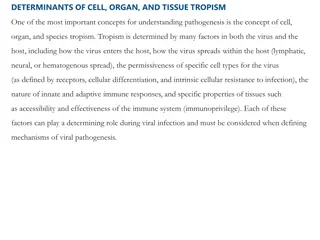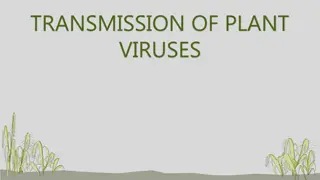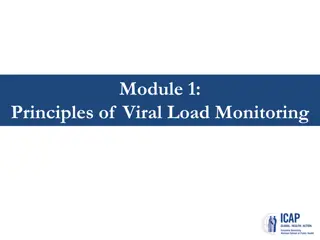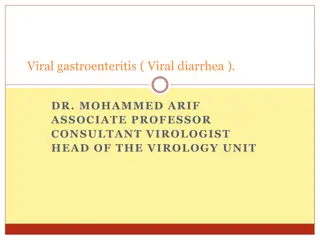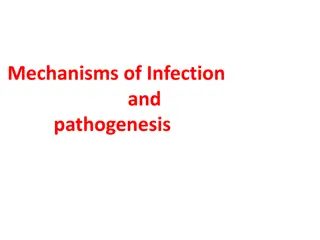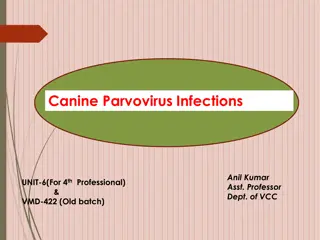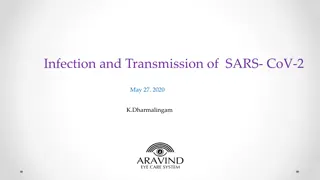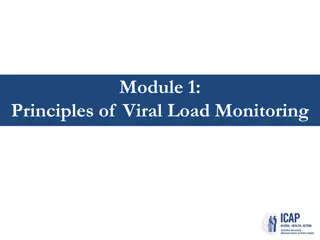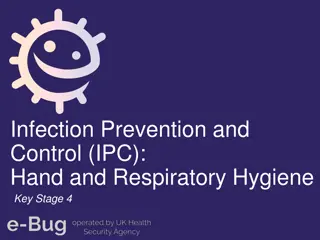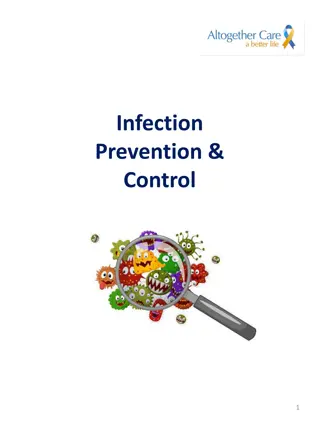Understanding Mechanisms of Viral Infection and Spread
Viral infection involves a replicative cycle within the host, leading to a range of cellular responses from no apparent effect to disease. Factors such as virulence genes, host characteristics, and viral genome influence the pathogenicity and virulence of a virus. The process includes entry into the host, replication, spread, evasion of immune defenses, and ultimately causing damage. Chronic infection persists beyond the expected clearance time, involving mechanisms like nucleic acid persistence, latency, and reactivation.
Download Presentation

Please find below an Image/Link to download the presentation.
The content on the website is provided AS IS for your information and personal use only. It may not be sold, licensed, or shared on other websites without obtaining consent from the author. Download presentation by click this link. If you encounter any issues during the download, it is possible that the publisher has removed the file from their server.
E N D
Presentation Transcript
Mechanisms of Infection and Viral Spread through the Body
The fundamental process of viral infection is the viral replicative cycle. The cellular response to that infection may range from no apparent effect,to cytopathology with accompanying cell death to hyperplasia or cancer. Viral disease is some abnormality that results from viral infection of the host. Viral pathogenesisrefers to the interaction of viral and host factors that leads to disease production. A virus is pathogenic for a particular host if it can infect and cause signs of disease in that host. A strain of a certain virus is more virulent than another strain if it commonly produces more severe disease in a susceptible host. The term virulent is used as relative measure of the pathogenicity of infected virus. The term pathogenicity and virulence refer to the capacity of viruses to cause disease in a host. Virulence is determined by the capacity of a virus to (a) Grow. (b) Be invasive, (c) Infect cells, (d) Evade the immune system, and (e) Cause tissue damage.
These capacities are encoded in the viral genome, by individual virulence genes or by allelic variations in viral genes. The virulent dependent on both viruses and host, and influenced by factors: 1- such as dose and rout of entry of the virus and species. 2-age, sex and immune status of the host. Virus infection may result in sub- acute, acute or chronic disease. Productive, Abortive, and Latent Infection Productive Infection is the process by which a virus introduces its genome into a cell. Infection is productive if new infectious virus is made. Abortive if no new infectious virus is produced. Infection is latent if the production of infectious virus does not occur immediately, but the virus retains the potential to initiate productive infection at a later time. A cell is permissive if it can support productive infection, and not permissive if infection cannot occur at all or is abortive. Acute infection occurs when a virus first infects a susceptible host .
Chronic or persistent infection is the continuation of infection beyond the time when the immune system might reasonably be expected to clear acute infection. It is important to note that these terms mean the presence of viral infection in the host for long Mechanisms responsible for chronic infection include persistence of nucleic acid, continuous replication, latency, and reactivation. Obligatory Steps in Viral Infection 1-Entry into host and primary viral replication, Evade host's natural protective and cleaning mechanisms. 2-Local or general spread in the host, cell and tissue tropism, and secondary viral replication. Evade immediate host defenses and natural barriers to spread; at the cellular level the virus takes over necessary host cell functions for its own replication processes 3-Evasion of host inflammatory and immune defenses Evade host inflammatory, phagocytic, and immune defenses long enough to complete the viral transmission cycle. 4- Shedding from host, Exit host body at site and at concentration needed to ensure infection of the next host. 5-Cause damage to host, Not necessary, but this is the reason we are interested in the virus and its pathogenic processes.
Entry of the virus Entry via the Respiratory Tract The mucosal surfaces of the respiratory tract have living cells at their surfaces; these cells can support the replication of many viruses. The respiratory tract is ordinarily protected by two effective cleaning systems: (1)a blanket of mucus (2) The coordinated beating of ciliated epithelial cells lining the upper and much of the lower respiratory tract. Most inhaled virions are trapped in mucus, carried by ciliary action from the nasal cavity and airways to the pharynx, and then swallowed or coughed out. All viruses that infect the host via the respiratory tract probably do so by attaching to specific receptors on epithelial cells within the mucosa, avoiding mucociliary blanket or phagocytic cell. Following respiratory invasion, many viruses remain localized (e.g., adenoviruses, and influenza viruses of mammals) Whereas others become systemic by disseminated via lymphatics or bloodstream (e.g., ,rinderpest virus, and Newcastle disease virus).
Entry via the Oropharynx and Intestinal Tract Many viruses are acquired by ingestion. They may either be swallowed and reach the stomach and intestine directly or they may first infect cells in the oropharynx, their progeny being eventually carried into the intestinal tract. The esophagus is rarely infected, probably because of its tough epithelium and the rapid passage of swallowed material over its surface. The gastrointestinal tract is protected by several defenses including: 1- mucus which cover stomach and intestine. 2- acidity of stomach. 3-contain specific secretory antibodies (IgA)which produce by B lymphocytes in gastrointestinal mucosa and mucosal associated lymphoid tissue. 4- the antimicrobial activity of digestive enzymes. 5- bile and pancreatic secretions. Virions first infect the epithelial cells lining the gastro-intestinalmucosa or from where they may be passed to adjacent mononuclear cells where they may replicated In general, viruses that cause intestinal infection, such as rotaviruses, caliciviruses, and enteroviruses are acid and bile resistant.
Entry via the Skin The skin is the largest organ of the body, its characterized as: 1-consists of keratinized cells, it provides a tough and usually impermeable barrier to the entry of viruses. 2-the low PH and presence of fatty acids provide further protection. 3-various components of innate and adaptive immunity Breaches in skin integrity such as cuts, punctures, abrasions, or wounds predispose for viral infection, which can either remain in skin as in Papillomaviruses Deeper trauma may introduce viruses into the dermis with its rich supply of vessels, lymphatics, and nerves, or even into the underlying subcutaneous tissue and muscle. One of the most efficient ways by which viruses are introduced through the skin is via the bite of arthropods, such as mosquitoes, ticks, Insects, especially flies, may act as simple mechanical vectors, Infection can also be acquired through the bite of an animal, as in rabies.
Entry via Other Routes The urogenital tract is the route of entry of several important pathogens (e.g., bovine herpesvirus1, equine herpesvirus3, and porcine papillomavirus). Small tears or abrasions in the penile mucosa and the epithelial lining of the vagina may occur during sexual activity and permit the entry of virus. The conjunctiva, although much less resistant to viral invasion than the skin, is constantly cleansed by the flow of secretion (tears) and is wiped by the eyelids; some adenoviruses and enteroviruses gain entry in this way. Host Specificity and tissue Tropism The capacity of a virus to selectively infect cells in particular organs is referred to as tropism. Viral tropism depends on viral and host factors. At the cellular level, there must be an interaction between viral attachment proteins and matching cellular receptors and co- receptors.
Mechanisms of Spread in the Body Local Spread on Epithelial Surfaces Many viruses replicate in epithelial cells at the site of entry and produce a localized or spreading infection in the epithelium some are then shed directly into the environment from these sites. Spread via the Blood stream" Viremia it may occur during the transfusion of infected blood (e.g., transmission of immunodeficiency virus) or by use of non sterile instruments . The bite of arthropod vectors also allows direct entry of virus into the bloodstream. The blood is the most effective and rapid vehicle for the spread of virus through the body. Once a virus has reached the bloodstream, usually via the lymphatic system it can localize in any part of the body within minutes. The first entry of virus into the blood is called primary viremia. This early viremia may be clinically silent. Virus replication in major target organs leads to the sustained production of much higher concentrations of virus, producing asecondary viremia which can in turn lead to the establishment of infection in yet other parts of the body.
Spread via Nerves An important route of infection of the central nervous system is via the peripheral nerves, as seen, for example, in rabies virus encephalitis, pseudorabiesvirus. As these viruses move centripetally, they must cross cell-cell junctions. Rabies virus and pseudorabies virus are known to cross at synaptic junctions. Spread via respiratory system Initial injury is followed by progressive infection of epithelial cells within the mucosa and inflammation of increasing severity, with exudation of fluid and influx of inflammatory cells, more and more epithelial cells and eventually in the most severe infections there is acidosis, edema, and massive epithelial sloughing. Infection of the Intestinal Tract The intestinal epithelium is usually infected directly by ingested virions, (rotavirus, coronavirus)but sometimes viremic infections(parvovirus) reach the intestinal epithelium, also causing enteritis and diarrhea. The pathophysiologic effects of viral diarrhea are a consequence of rapid destruction of epithelial cells and their replacement by immature cells that cannot carry out normal
Infection of the Skin As well as being a site of initial infection, the skin may be invaded secondarily via the bloodstream, producing erythema (inflammation), which may be generalized but more often is localized and seen readily on exposed, hairless, nonpigmented areas. Infection of the Central Nervous System Viruses can spread from distal sites to the brain via nerves. Viruses can also spread from the blood to the brain Subsequent spread in the central nervous system can take place via intercellular spaces or by the sequential infection of neural cells. Lytic infections of neurons, whether due to togaviruses, herpesviruses, or other viruses, lead to the hallmarks of encephalitis Other characteristic pathologic changes are produced by various viruses and prions that cause slowly progressive diseases of the central nervous system. In most cases, central nervous system infection seems to be a dead end in the natural history of viruses
Infection of the Fetus Most viral infections of the dam have no harmful effect on the fetus, but some blood-borne viruses cross the placenta to reach the fetal circulation, sometimes after establishing foci of infection in the placenta Severe cytolytic infections of the fetus cause fetal death and resorption or abortion Infection of the salivary glands or mammary glands may lead to lesions in those organs and excretion of virus in saliva or milk. Mechanisms of Virus Shedding Shedding of infectious virions is crucial to the maintenance of infection in populations .Exit usually occurs from one of the body openings or surfaces that are involved in viral entry. (particularly respiratory and intestinal epithelium), the same body opening is involved in entry and exit in generalized infections, a greater variety of sites of shedding is recognized and some viruses are shed from multiple sites. The amount of virus shed in an excretion or secretion is important in relation to transmission.
Viral Shedding 1- Viral Shedding from the Respiratory Tract Many different viruses that cause localized disease of the respiratory tract are shed in mucus or saliva and are expelled from the respiratory tract during coughing, sneezing, e.g. Influenza and pneumoviruses. Respiratory viruses,are excreted in both nasal and oral secretions. Viruses are also shed from the respiratory tract in several systemic infections. 2- Viral Shedding from the Oropharynx and Intestinal Tract Enteric viruses are shed in the feces, and the more voluminous the fluid output the greater is the environmental contamination they cause. Enteric viruses are in general more resistant to inactivation by environmental conditions than respiratory viruses; especially when suspended in water, such viruses can persist for some time. A few viruses are shed into the oral cavity from infected salivary glands (e.g., rabies virus and cytomegaloviruses) or from the lungs or nasal mucosa. Salivary spread depends on many factors.
3- Viral Shedding from the Skin The skin is an important source of virus in diseases in which transmission is by direct contact or via small abrasions: papillomaviruses and herpesviruses employ this mode of transmission. 4- Viral Shedding from the Urine and feces Urine, feces, tends to contaminate food supplies and the environment. A number of viruses (e.g., rinderpest virus) replicate in tubular epithelial cells in the kidney and are shed in urine. 5- Viral Shedding from the Genital Tract Several viruses that cause important diseases are excreted in the semen and are transmitted during coitus. Viruses shed from the genital tract depend on mucosal contact for successful transmission. 6- Viral Shedding in Milk Several viruses replicate in the mammary gland and are excreted in milk, which may serve as a route of transmission, e.g., mouse mammary tumor virus, and some of the tick-borne flaviviruses.
7- Viral Shedding via Blood and Tissues Although not "shedding" in the usual sense of the word, blood and tissues from slaughtered animals must be considered important sources of viral contagion. Blood is the usual source from which arthropods acquire viruses, and blood may also be the source of viruses transferred to the avian egg or mammalian fetus. Infection without Shedding Many sites of viral replication might be considered "dead ends" Many retroviruses are not shed at all, but instead are transmitted directly in the germplasm or by infection of the avian egg or developing mammalian embryo .




